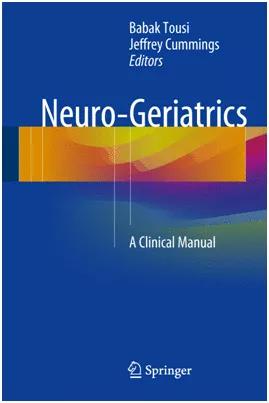24-chapter text is comprehensive but tailored to busy clinicians
Clinicians who see a lot of elderly patients — be they geriatricians, neurologists, geriatric psychiatrists or primary care physicians — have few resources specific to brain disorders in older adults. Geriatrics books abound and neurology texts are beyond counting, yet textbooks on neurogeriatrics remain rare.
Advertisement
Cleveland Clinic is a non-profit academic medical center. Advertising on our site helps support our mission. We do not endorse non-Cleveland Clinic products or services. Policy
That’s the void Cleveland Clinic experts Babak Tousi, MD, and Jeffrey Cummings, MD, ScD, set out to fill by co-editing Neuro-Geriatrics: A Clinical Manual, a comprehensive new teaching manual for clinicians.
The book, available from Springer in print and e-book versions, draws on the expertise of 35 specialist authors in 24 chapters across 407 pages to take a decidedly practical approach to neurodegenerative, vascular and traumatic brain disorders that are common in older persons or have a dramatic impact on their lives.

Individual chapters are devoted to a variety of common dementias, Parkinson disease and related disorders, rapidly progressive CNS diseases and more, including geriatric-specific discussions of conditions such as epilepsy, sleep disorders, ischemic stroke and gait disorders. Additional chapters focus on the neuropsychological evaluation in older adults, the office approach to neurological disease in the elderly, and psychiatric symptom management in neurodegenerative disorders.
Structurally, the format is designed for easy use by the clinician, with nearly all chapters containing the following features:
In many chapters, the above components are presented in the context of care paths for the condition in question. “Our aim is to provide standards of care and decision-support algorithms for diagnosis and treatment,” explains co-editor Dr. Tousi, a staff physician with Cleveland Clinic Lou Ruvo Center for Brain Health in Cleveland with fellowship training and extensive clinical experience in geriatrics and neurology. “Care paths are an effective way to approach the architecture of care by defining needed actions (such as clinical evaluation, lab studies or brain imaging), decision points, and criteria for treatment initiation and monitoring, and then linking these elements to anticipated outcomes and costs of care.”
Advertisement
Recommendations throughout the book are founded in evidence-based medicine, with copious reference citations and incorporation of expert opinion where data are lacking. Therapy recommendations comprise both pharmacologic and nonpharmacologic interventions, and include the latest developments, such as the use of pimavanserin for hallucinations and delusions in Parkinson disease.
Particular attention is devoted to issues that loom especially large in the geriatric population, such as neurobehavioral changes, caregiver issues and the complexity of multiple comorbid conditions — as well as to genetics, where applicable.
“Genetics now has meaningful clinical application in neurogeriatric care,” says co-editor Dr. Cummings, Director Emeritus of the Lou Ruvo Center for Brain Health and a veteran investigator in therapeutic trials for Alzheimer’s disease (AD) and other neurodegenerative disorders. “We have included discussion of genetic information where it can help in diagnostic assessment — such as for early-onset AD, for inherited forms of frontotemporal dementia or for ApoE-4 in AD —and where it may guide treatment, as in cases of polymorphisms that affect drug metabolism. The approaches suggested in our book can facilitate the use of biomarkers, including genetics, to achieve greater treatment efficacy and diminished side effects on the path toward precision medicine.”
In addition to more precise medicine, the book aims to foster what it dubs more “person-centric” care for older patients with neurologic diseases. “Patient-reported outcomes are increasingly included in clinical trials in this patient population, to insure that patients’ goals are prominently considered in therapy development,” says Dr. Tousi. “Likewise, our book aims to provide a framework to help clinicians consider person-centricity in every step of the care path for these patients.”
Advertisement
Advertisement

Multidisciplinary approach helps address clinical and psychosocial challenges in geriatric care

Effective screening, advanced treatments can help preserve quality of life

Study suggests inconsistencies in the emergency department evaluation of geriatric patients

Auditory hallucinations lead to unusual diagnosis

How providers can help prevent and address this under-reported form of abuse

How providers can help older adults protect their assets and personal agency

Recognizing the subtle but destructive signs of psychological abuse in geriatric patients

Early screening — and shorter boarding times — benefit older adults